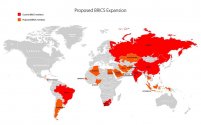The BRICS nations announced plans to launch a new reserve currency for trade. The BRICS alliance indicated it would be a basket currency. What does that mean? How does a basket currency work? A speculative thread on the upcoming BRICS reserve currency.
For the past 80 years, global trade has been done primarily in US dollars. However, that arrangement has pros and cons for various nations. Consequently, many countries have expressed a strong desire to trade outside the dollar system.
The BRICS nations - Russia, China, India, Brazil and South Africa - formed an alliance and recently announced plans to use a new currency for trade settlement.
Since the Triffin Dilemma puts a burden on nations that issue the reserve currency AND export goods, it’s not beneficial for any BRICS member to have their currency function as the trade currency. An alternative option is a basket currency.
This is not a new concept, as it was proposed in 1944 as Bancor, and the IMF has the SDR as a reserve asset. But the BRICS proposal includes a new element that wasn’t part of the other basket currencies.
This new currency is expected to be a digital asset based currency, and functions like poker chips.
Each nation assembles their stash of assets, and based on the value of those assets are given a specific number of poker chips.
In the SDR model, the poker chips are based on a contribution of currency alone. The BRICS nations will allow nations to leverage value from currency AND assets like gold, silver, oil and commodities. The assets function like collateral in a loan.
They are not intended to be spent like money, or traded, but used to secure the value of the poker chips. This would give nations with a smaller GDP another way to secure more reserve assets for trade, and for storage of wealth. How would those assets be valued?
That’s not entirely clear, but it is speculated that all assets will be priced in gold. If a nation were determined to have 1 million grams of gold worth of assets in their reserves, a comparable amount of digital assets would be minted to reflect that value.
Could a nation outside the BRICS alliance still trade even though they don’t have the BRICS reserve asset? Yes, this is where Ripple's ODL platform fits in.
Nations could swap their asset (BRICS currency, dollars or another reserve asset used by banks) for XRP, which is swapped for the asset they need to complete the trade.
Because this arrangement for ODL potentially includes ANY asset that could be classified as value (gold, real estate, derivatives, sovereign currency), the total value of XRP has to support enough liquidity to enable massive nation -to-nation trades.
While it’s impossible to calculate exactly what that would be, it’s clear that a low value like $10 would not be sufficient.
The BRICS reserve currency concept will enable member nations to tokenize their assets and use that value as collateral for trade settlement.
There is no reason why other sovereigns could not adopt a similar model to increase their buying power, and move away from using debt to fund their nations’ trade in the global marketplace.

